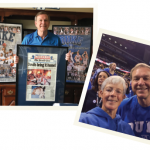In 1985, patients in wheelchairs and significant joint deformities were still a common sight in waiting rooms in rheumatology practices. The era of early aggressive therapy was only beginning and patients newly diagnosed with rheumatoid arthritis (RA) might have been hospitalized for a week and treated with gold shots. Many patients faced a poor prognosis, with a life of significant pain and disability and possible joint replacement surgery. At the same time, within the ACR—known then as the American Rheumatism Association and newly separated from the Arthritis Foundation—the cornerstones were set for the ACR Research and Education Foundation (REF).
Twenty-five years later, wheelchairs are largely absent from waiting rooms. A patient newly diagnosed with RA is treated as an outpatient and has a good probability of remission with today’s disease-modifying therapies. And the REF is the second-largest funding source of rheumatic disease research, after the National Institutes of Health (NIH). In 2009 alone, the REF awarded $5 million in career development grants. As of 2010, $24 million has been awarded to fund 54 RA projects through the Within Our Reach: Finding a Cure for Rheumatoid Arthritis campaign. As the REF celebrates its silver anniversary, several ACR members who have had important roles in the REF spoke with The Rheumatologist about the foundation’s birth and growth into a major funder of rheumatology research and education.
Foundation’s First Steps
“The priority was to re-emphasize and re-establish identity of the field of rheumatology in the United States, and the REF was part of that,“ says William N. Kelley, MD, professor of medicine at the University of Pennsylvania in Philadelphia and secretary and, later, president of the ACR when the REF was being formed. “There was a general level of discontent with the funding situation in rheumatology at the time, particularly how much went to administrative costs.” In 1985, the REF was established as an ACR-affiliated nonprofit organization that would be able to accept charitable donations.
In its early years, the REF’s modest grant and award portfolio focused on funding research and training rheumatologists. In 1993, its three main activities were the Medical Student Summer Research Award, the ACR Arthritis Investigator Award, and the Physician Scientist Development Award. Current REF treasurer, Audrey Uknis, MD, associate dean of admissions and professor of medicine at Temple University School of Medicine in Philadelphia, received the Physician Scientist Development Award in the early nineties (see “REF Education Investment Yields Positive Results,” p. 38). “The REF award gave me a sense early in my career that there was an organization with a purpose that was critical for career development in burgeoning young rheumatologists,” says Dr. Uknis. During the 1990s, as interest in subspecialty training, including rheumatology, dropped among medical students, the REF worked to attract students, residents, and fellows to the subspecialty. In 1997, the REF began supporting fellowship training.
